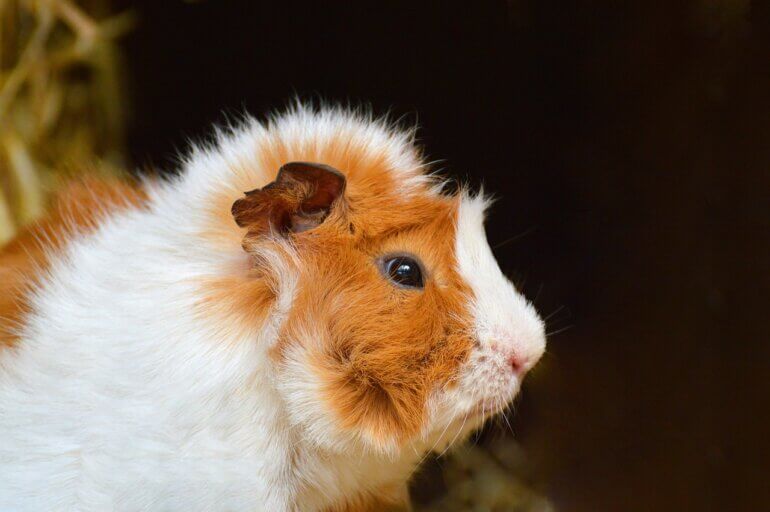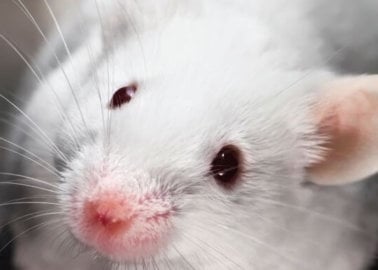10 Horrific Experiments on Guinea Pigs
Guinea pigs are one of the many species tormented in laboratories, with as many as 3,814 scientific procedures carried out on guinea pigs in Great Britain in 2022.
Guinea pigs are affectionate and social animals who purr when happy, jump when excited, and prefer to live in groups. However, experimenters gas these gentle animals, inject them with poison, and dissect them. Speciesism has led experimenters to treat these sensitive individuals as mere test tubes. Below are 10 examples of UK and EU experiments on guinea pigs.
- Confined to Tubes and Forced to Inhale a Solvent
The Acute Vapour Inhalation Toxicity of 2-Butoxyethanol
In the UK, guinea pigs were used to test the acute vapour inhalation toxicity of 2-butoxyethanol, a solvent found in paints, inks, cleaners, and other products. Experimenters confined guinea pigs in tubes for four hours and forced them to inhale the solvent. The conditions were so severe that one guinea pig, whose eyes were dull and who was experiencing laboured breathing, impaired movement, and weight loss, was killed by experimenters due to “welfare” concerns. Post-mortem examinations revealed a perforated colon, gastrointestinal distension, and other severe internal damage. - Exposed to a Deadly Nerve Agent, Which Caused Tremors
Testing the Efficacy of Oxime HI-6 Dimethanesulphonate Against Nerve Agents
In a disturbing experiment conducted in the UK, the Ministry of Defence exposed guinea pigs to the deadly nerve agent Sarin. The guinea pigs suffered from tremors, excessive salivation, and hypothermia. Even if they survived the initial exposure, they were killed within 24 hours. - Infected With Ebola Virus
Therapeutic Monoclonal Antibodies for Ebola Virus Infection
In another UK study, guinea pigs were infected with the Ebola virus to test the antibodies derived from vaccinated humans. The guinea pigs were monitored for symptoms such as rapid weight loss and fever. If they lost a significant amount of weight or showed severe reactions, experimenters killed them. - Exposed to Loud Sounds, Which Damaged Hearing
Inducing Tinnitus in Guinea Pigs
Guinea pigs were subjected to experiments to induce tinnitus – a painful, constant ringing in the ears. Experimenters surgically implanted devices near the animals’ ears and exposed them to loud noises at damaging volumes. The guinea pigs developed the condition, which is characterised by a painful and constant ringing in the ears. Tinnitus is already widely studied in humans, so this pointless experiment does nothing but torture guinea pigs. - Holes Drilled Into Necks
Salicylate Experiments on Auditory System
Experimenters anaesthetised guinea pigs, surgically created a hole in each animal’s neck (tracheotomy), and connected them to an artificial respirator. They gave the guinea pigs a high dose of the active ingredient found in aspirin to induce tinnitus, attached them to a frame that held them in place inside a sound-proof booth, and inserted hollow bars into their ears. Experimenters then removed part of the brain, filled the cavity with agar and saline, and blasted 100 decibels of noise into each ear. - Forced to Undergo Brain Surgeries
Experiments on Auditory System
Some of the experimenters from the preceding study exposed 26 guinea pigs aged 2 to 9 months to loud noises to see if they developed tinnitus. Experimenters anaesthetised them and exposed them to loud noises for extended periods, causing hearing damage. Loud noises were played into one ear while the other ear was folded over and covered with a cotton wool–stuffed plastic tube. Once the animals were awake, the experimenters measured their hearing by making sudden noises to startle them. They then put them through another surgery to reveal their skulls, expose their brain (craniotomy), and implant electrodes from their ears to their brains. The electrodes emitted pulses to measure the animals’ brain activity. - Exposed to Loud Noises and Killed
Hearing Loss and Drug Testing
In Germany, experimenters exposed 57 unconscious guinea pigs to extremely loud noises to induce hearing damage. Then, they injected the animals’ ears with a drug to test its effects against hearing loss. The guinea pigs underwent multiple hearing tests before experimenters killed them and examined their bodies. These defenceless animals suffered and died for a pointless experiment. - Jaws Physically Removed
Cochlear Implants and Long-Term Drug Release
In another German study, experimenters implanted drug-loaded silicone rods into the ears of 45 female guinea pigs. These individuals endured multiple invasive procedures, including to remove parts of their jaw so that experimenters could manipulate their inner ear. At the end, they were killed. - Forced to Run, Then Killed
Endurance Training and Cardiac Remodelling
Experimenters in Hungary forced 38 guinea pigs to run on a treadmill in a study of cardiac remodelling. Five times a week, the animals were made to run for extended periods of up to 90 minutes. Laboratory workers increased the speed and incline of the treadmill and monitored the guinea pigs’ heart activity, then they killed them, cut their dead bodies open, and extracted their hearts. - Squeezed Into Plastic Tubes and Gassed
Allergic Asthma Induction
In Slovakia, experimenters used guinea pigs to study allergic asthma. They placed the animals in plastic tubes filled with gas to test their respiratory responses. The guinea pigs had severe allergic reactions that led to difficulty breathing and, in some cases, death.
Experimenting on Guinea Pigs Is Terrible Science
Guinea pigs are biologically, metabolically, and physically different to humans. Testing on animals is not only cruel but also bad science that can hold us back from making scientific breakthroughs.
The world’s forward-thinking scientists are developing and using non-animal methods that are actually relevant to human health for studying diseases and testing products.
These modern approaches include sophisticated tests that use human cells and tissues (also known as in vitro methods), advanced computer-modelling techniques (often referred to as in silico models), and studies involving human volunteers. These and other non-animal methods are not hindered by the differences between species that make it difficult – if not impossible – to apply the results to humans. They also usually take less time and money to complete.
How You Can Help Create Change
The UK could be a world leader in modern, non-animal science. Urge the UK government to phase out experiments on animals now:




